

|
| FRANCE | FRANCE |
| région: Provence-Alpes-Côte d'Azur | |
| département: 13, Bouches-du-Rhône |
Marseille (Provençal Occitan: Marselha in classical norm or Marsiho in Mistralian norm) is the second-largest city of France with about 821,000 inhabitants (2005 estimate) and forms the third-largest metropolitan area with about 1,605,000 inhabitants (2007). Located on the Mediterranean Sea, it is France's largest commercial port. Marseille is also the capital of the région Provence-Alpes-Côte d'Azur, as well as the préfecture (capital) of the département Bouches-du-Rhône.
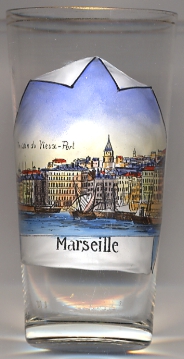
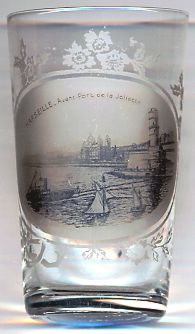 Man has inhabited Marseille and its environs for almost 30,000 years: paleolithic cave paintings in the underwater Cosquer cave near the calanque of Morgiou
date back to between 27,000 and 19,000 BC; and very recent excavations near the railway station have unearthed paleolithic habitations from around 6,000 BC.
Marseille was founded in 600 BC by Greeks from Phocaea (Foça, Turkey) as a trading port under the name Μασσαλία (Massalía).
Massalia was the first Greek port in Western Europe, growing to a population of over 1,000. It was the first settlement given city status in what today is France.
Facing an opposing alliance of the Etruscans, Carthage and the Celts, the Greek colony allied itself with the expanding Roman Republic for protection.
Under this arrangement the city maintained its independence until the rise of Julius Caesar, when it joined the losing side (Gnaeus Pompeius Magnus and the optimates)
in civil war, and lost its independence in 49 BC. It was the site of a siege and naval battle in which the fleet was confiscated by the Roman authorities.
During the Roman times the city was called Massalia. Most of the archaeological remnants of the original Greek settlement were replaced by later Roman additions.
Marseille thrived as a Roman trading port. It was during this time that Christianity first appeared in Marseille, as evidenced by catacombs above the harbour and
records of Roman martyrs.
Man has inhabited Marseille and its environs for almost 30,000 years: paleolithic cave paintings in the underwater Cosquer cave near the calanque of Morgiou
date back to between 27,000 and 19,000 BC; and very recent excavations near the railway station have unearthed paleolithic habitations from around 6,000 BC.
Marseille was founded in 600 BC by Greeks from Phocaea (Foça, Turkey) as a trading port under the name Μασσαλία (Massalía).
Massalia was the first Greek port in Western Europe, growing to a population of over 1,000. It was the first settlement given city status in what today is France.
Facing an opposing alliance of the Etruscans, Carthage and the Celts, the Greek colony allied itself with the expanding Roman Republic for protection.
Under this arrangement the city maintained its independence until the rise of Julius Caesar, when it joined the losing side (Gnaeus Pompeius Magnus and the optimates)
in civil war, and lost its independence in 49 BC. It was the site of a siege and naval battle in which the fleet was confiscated by the Roman authorities.
During the Roman times the city was called Massalia. Most of the archaeological remnants of the original Greek settlement were replaced by later Roman additions.
Marseille thrived as a Roman trading port. It was during this time that Christianity first appeared in Marseille, as evidenced by catacombs above the harbour and
records of Roman martyrs.
Glass no. 2867 [left] shows a view of  vieux-port
vieux-port avant-port
avant-port
With the decline of the Roman empire the town reverted to the hands of the Gauls, eventually joining much of France under the rule of the Franks. Emperor Charlemagne and the Carolingian dynasty granted civic power to Marseille, which remained a major French trading port until the medieval period. The city regained much of its wealth and trading power when it was revived in the 10th century by the counts of Provence. In 1347 the city suffered terribly from the bubonic plague. The city's fortunes declined still further when it was sacked and pillaged by the Aragonese in 1423. Marseille soon revived its population and trading status in the Mediterranean and in 1437, the Count of Provence René of Anjou, who succeeded his father Louis II of Anjou, as King of Sicily and Duke of Anjou, arrived in Marseille and established it as France's most fortified settlement outside of Paris. He helped raise the status of the town to a city and allowed certain privileges to be granted to it. Marseille was then used by Duke of Anjou as a strategic maritime base to reconquer his kingdom of Sicily. Marseille became a part of France in 1481 but soon acquired a reputation for rebelling against the central government.
Over the course of the 18th century, the port's defenses were improved and Marseille became more important as France's leading military port in the Mediterranean. The local population enthusiastically embraced the French Revolution and sent 500 volunteers to Paris in 1792 to defend the revolutionary government; their rallying call to revolution, sung on their march from Marseille to Paris, became known as La Marseillaise, now the national anthem of France. During the nineteenth century the city was the site of industrial innovations and a growth in manufacturing. The rise of the French Empire and the conquests of France from 1830 onward (notably Algeria) stimulated the maritime trade and raised the prosperity of the city. Maritime opportunities also increased with the opening of the Suez Canal in 1869. During the first half of the twentieth century, Marseille celebrated its trading status and 'port of the empire' status through the colonial exhibitions of 1906 and 1922. In 1934 Alexander I of Yugoslavia arrived at the port to meet with the French foreign minister Louis Barthou. He was assassinated there by the Bulgarian revolutionary Vlado Černozemski. He was also thought to have shot and killed Barthou until 1974, when it was revealed that the bullet actually came from a French policeman reacting to the shooting of King Alexander. During World War II, Marseille was bombed by the German and the Italian forces in 1940. The city was occupied by Germans and over one-third of the city's old quarter was destroyed in a massive clearance project, aimed to reduce opportunities for resistance members to hide and operate in the densely populated old buildings. After the war much of the city was rebuilt during the 1950s. The governments of East Germany, West Germany, and Italy paid massive reparations, plus compound interest, to compensate civilians killed, injured, or left homeless or destitute as a result of the war. From the 1950s onward, the city served as an entrance port for over a million immigrants to France, many of whom came in 1962 from Algeria. Together with Košice (Slovakia), Marseilles was selected to be European Capital of Culture for 2013.
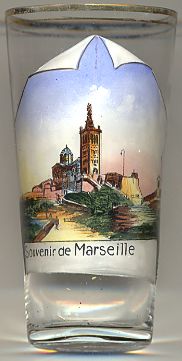
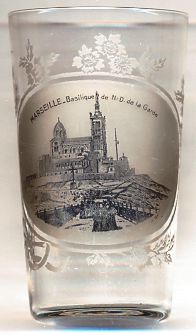
The  Basilique de Notre Dame de la Garde [left, no. 2518; right, no. 2371]
sits atop the signal hill of La Garde, the highest natural point in Marseille, being a 162 m limestone outcrop on the south side of the Vieux Port.
As well as being a major local landmark, it is the site of a popular annual pilgrimage every 15th of August (Assumption of Our Lady).
Designed by the architect Henri-Jacques Espérandieu, the church was built between 1853 and 1864. The site was a 13th century chapel also dedicated to Our Lady of the Guard,
filled with the ex-votos of safely returned sailors. The basilica is surmounted by a 60 m belfry topped with a huge statue of the Virgin and Child, visible across much
of the city and from miles out at sea.
Basilique de Notre Dame de la Garde [left, no. 2518; right, no. 2371]
sits atop the signal hill of La Garde, the highest natural point in Marseille, being a 162 m limestone outcrop on the south side of the Vieux Port.
As well as being a major local landmark, it is the site of a popular annual pilgrimage every 15th of August (Assumption of Our Lady).
Designed by the architect Henri-Jacques Espérandieu, the church was built between 1853 and 1864. The site was a 13th century chapel also dedicated to Our Lady of the Guard,
filled with the ex-votos of safely returned sailors. The basilica is surmounted by a 60 m belfry topped with a huge statue of the Virgin and Child, visible across much
of the city and from miles out at sea.
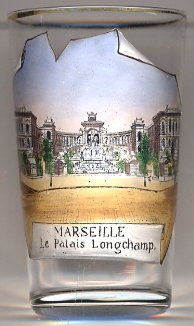
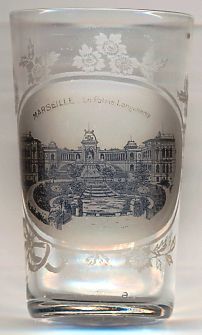
The  Palais Longchamp [left, no. 2914; right, no. 2373] is one of Marseille's most prominent landmarks, situated in the quartier Cinq Avenues.
It was built in 1862 by Henri-Jacques Espérandieu in order to celebrate the opeing of the Canal de Marseille that brought water from the Durance river into the city.
Today, the Palais Longchamp is home to two museums: The Musée des Beaux-Arts in the left aisle and the Muséum d'Histoire Naturelle in the right aisle.
Until 1987 the park around the palais housed the Marseille zoological garden.
Palais Longchamp [left, no. 2914; right, no. 2373] is one of Marseille's most prominent landmarks, situated in the quartier Cinq Avenues.
It was built in 1862 by Henri-Jacques Espérandieu in order to celebrate the opeing of the Canal de Marseille that brought water from the Durance river into the city.
Today, the Palais Longchamp is home to two museums: The Musée des Beaux-Arts in the left aisle and the Muséum d'Histoire Naturelle in the right aisle.
Until 1987 the park around the palais housed the Marseille zoological garden.
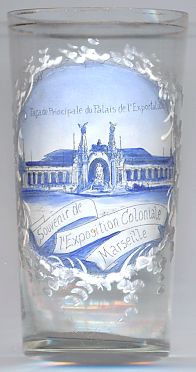
The  Palais de l'Exportation [left, no. 2370]
was a building created for the Exposition Coloniale of 1906. The fair was the first of its kind that was held in France
and attracted some 1,800,000 visitors between April 15 and November 15 of that year.
The Palais de l'Exportation consisted of a classicizing colonnade with a central monumental arch.
The palais was replaced later by the current Grand Palais.
Palais de l'Exportation [left, no. 2370]
was a building created for the Exposition Coloniale of 1906. The fair was the first of its kind that was held in France
and attracted some 1,800,000 visitors between April 15 and November 15 of that year.
The Palais de l'Exportation consisted of a classicizing colonnade with a central monumental arch.
The palais was replaced later by the current Grand Palais.
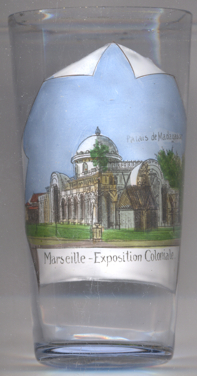
The  Palais de Madagascar [near left, no. 3292]
also was built for the Exposition Coloniale of 1906. It was a curious mixture of Indo-Arab and colonial architecture:
trilobed arches formed a sort of veranda-gallery around the building, the central hall of which was covered by a dome.
Palais de Madagascar [near left, no. 3292]
also was built for the Exposition Coloniale of 1906. It was a curious mixture of Indo-Arab and colonial architecture:
trilobed arches formed a sort of veranda-gallery around the building, the central hall of which was covered by a dome.
[http://en.wikipedia.org/wiki/Marseille;
from http://en.wikipedia.org/wiki/Notre-Dame_de_la_Garde;
https://expo1906.histoires-ultramarines.fr/main.php?ouvre=autoExpend#page28]
![[scale]](lineal.jpg)